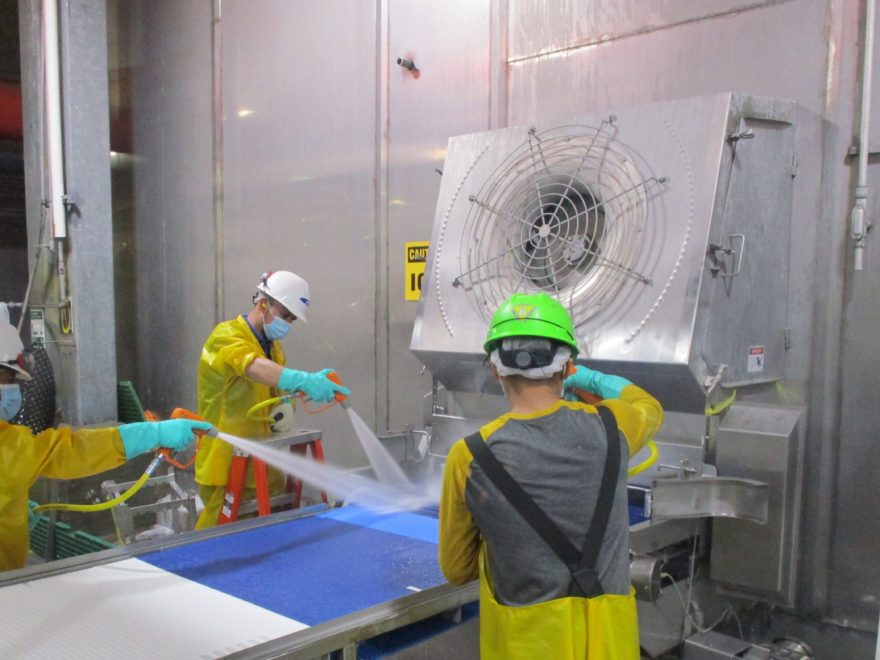Cleanliness and sanitation are both crucial in any food environment. Think of your kitchen in your home. You likely never start cooking a meal with dirty pans, and you probably work hard to clean your kitchen after every meal. Food processing facilities are the same way.
Processing Areas
We clean the areas where we make food, the processing areas, a lot like you’d clean your kitchen and cookware at home, only on a much larger scale. We also include a few added steps for sanitizing and testing to make sure our process works.
- First, all food, packaging materials and trash is picked up before the entire area is rinsed down.
- Next, all the equipment is cleaned with a detergent (soap) and can be subject to hand scrubbing, if needed, before it’s rinsed off.
- Then, it’s inspected for cleanliness, even before we use sanitizer. We also have specific criteria for any product that’s used for all this sanitizing. We make sure to meet the Centers for Disease Control and Prevention (CDC) cleaning and disinfection recommendations, including products that meet Environmental Protection Agency (EPA) criteria for use against SARS-Cov-2 (the virus that causes COVID-19).
- Finally, we collect samples of a random number of surfaces for presence of protein and/or bacteria. The presence of either would indicate that we need a “do-over” of the cleaning process. We do this every day to know how effective our cleaning process is.
If you think about it, this is not much different than what you do at home when you wash your dishes. I’m guessing you scrape any remnants into the trash, rinse, apply soap, then re-rinse and inspect them before putting them way or using them again. The main difference is that at home, the decision on effectiveness is based on a visual cue like the presence of dried food particles, whereas we go the extra mile. We make our decision based first on a visual cue during our “pre-operational” inspection (before we start making food) and then by the testing results. And did I mention that we do this every day?
We have confidence in this process, and you can too, because there is no evidence to support the implication that COVID-19 can be transmitted through food. The World Health Organization (WHO), the Centers for Disease Control & Prevention (CDC), the United States Department of Agriculture (USDA) and the U.S. Food & Drug Administration (FDA) all agree on this point.
Now that’s just speaking to the cleaning and sanitizing of our processing area where we make the food. We haven’t even started the conversation about common areas where our team members may congregate. Guess what? We clean those areas every day too!
Common Areas
Like you have experienced, COVID-19 has brought on challenges and taught us to adapt quickly to try to keep those we care about safe and healthy. You’ve probably increased your cleaning habits around your home – wiping down surfaces and cleaning areas where traffic is the highest. Again, we’re just the same.
We’ve made changes to the frequency of cleaning and the intensity of our cleaning procedures. First and foremost, it takes many more people to clean these areas than before. More people are needed because cleaning and sanitizing of common areas now happens around-the-clock. ALL common touch points – think door handles and tabletops – are continuously sanitized throughout the day while we are working, and then these areas are all cleaned AGAIN when the processing area undergoes the daily sanitation process.
Just think about that for a minute. We’re talking about doors, door handles, tabletops, chairs, time clocks, etc. in all common areas, inside and outside. These areas include offices, locker rooms, break rooms, hallways, restrooms, maintenance shops, etc. If you’re wondering if it takes a village to get this done, let me assure you that indeed it does!
But we are not done yet.
There’s More!
On top of all THAT, in response to COVID-19, we also routinely fog the entire facility – both the processing areas and the common areas – with another sanitizing product. Of course, this is also be in accordance with EPA criteria for use against SARS-Cov-2. Fogging is an additional step in cleaning that disperses a disinfectant aerosol to reduce the numbers of airborne micro-organisms and to apply disinfectant to surfaces that may be difficult to reach. Fogging gets up and into the nooks and crannies, so to say.
Just like you in your home, we know that proper cleaning and sanitizing is the key to preparing safe food and keeping those we care about safe and healthy.


